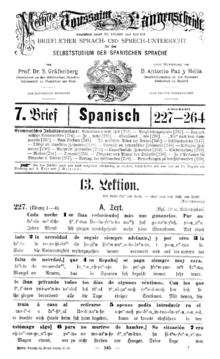Interlinear version

An interlinear version or interlinear translation is a word-for-word translation (lat. Versio ) between (lat. Inter ) the lines (lat. Lineas ) of a source text . In print editions, the equivalents in the target language appear under the words in the source text.
The aim is not a coherent translation in the form of a grammatically correct text in the target language, but the correspondence of individual words serves as an aid to understanding for readers of the source text, whereby several synonyms are often given over a word to choose from. An interlinear translation is necessarily structurally true to the sentence structure , i.e. it follows the structure of the source language.
Interlinear versions are at the beginning of Old High German literature. These translations were made in monastery schools to make learning the Latin language easier for prospective clergymen . The school of the Reichenau monastery is particularly well known for its numerous interlinear versions from the 8th and 9th centuries.
Often, interlinear versions are also used to make the Bible easier to read in the original languages. The most important Greek text edition of the New Testament , the Nestle-Aland text, has also been available with a German interlinear translation since 1986.
literature
- The Old Testament, interlinear translation, Hebrew / Greek-German, Stuttgart, 5 vols., 1993–2003, translated by Rita Maria Steurer.
- The New Testament, interlinear translation, Greek-German, Hänssler-Verlag, Stuttgart, 2nd edition 1995, translated by Ernst Dietzfelbinger.
See also
- Bible translation
- Linguistic interlinear glossing